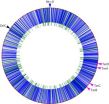(Press-News.org) COLUMBUS, Ohio - More than one-third of young adults who reported being victims of dating violence as teenagers had two or more abusive partners, a new study suggests.
The study involved 271 college students who recalled dating violence - including physical, sexual and psychological abuse - from ages 13 to 19.
Overall, nearly two-thirds of both men and women reported some type of abuse during their teenage years, which falls in line with other studies.
But it was surprising how many teen victims had two or more abusive partners, said Amy Bonomi, lead author of the study and associate professor of human development and family science at Ohio State University.
"For about one in three teens who were abused, it wasn't just one bad boyfriend or girlfriend. It may have been at least the start of a trend," Bonomi said.
The same patterns were not seen in similar population-based studies of adults, who tend to report abuse by a single partner, she said.
Well more than half of all teen victims reported multiple occurrences of abuse, with roughly 15 percent reporting 20 or more instances of some types of abuse.
"For most teens, dating violence is rarely reported as an isolated incident," said Bonomi, who is also an affiliate with the Group Health Research Institute in Seattle.
The study appears online in the journal BMC Public Health.
Among both males and females, psychological abuse - such as yelling, swearing, insults, controlling behavior, put-downs and name-calling - was the most common type of abuse.
One argument that violence researchers often hear is that behaviors like name-calling and insults aren't serious enough to be called abuse. But that's not true, Bonomi said.
"Studies in adults have shown that psychological abuse alone can be damaging to health," she said. She is currently studying whether the same is true for adolescents.
For this study, 271 students aged 21 and under at Ohio State completed a web-based survey about their dating history between ages 13 and 19.
The researchers used a method similar to what is called the timeline follow-back interview, which has been extensively used by researchers to study at-risk behavior such as substance abuse and risky sexual practices. However, this is the first time this type of interview technique has been used to study teen dating violence.
The technique involves asking participants to remember their most recent dating partner and asks questions about that relationship, and then works backward to the previous two relationships. This technique uses memory prompts, such as asking participants to remember the year they were in high school to facilitate recall of the age when a relationship began and ended.
The result showing that more than one-third of teen victims had more than one abusive partner was unexpected, Bonomi said.
"Our studies of adults showed that most women and men had only one abusive partner, so it was startling to find the number of teens who had two or more," she said.
For example, about 43 percent of women said two or more partners had pressured them into sex during their teenage years. About 60 percent of men said they had two or more partners who had sent unwanted calls or text messages.
Psychological abuse was the most common type of abuse reported in the study. The category of "yelling, swearing and insults" was the most frequently reported type of psychological abuse, noted by 43 percent of female victims and 44 percent of males.
Nearly 25 percent of females experienced sexual pressure due to a partner's persistent begging, compared to 11 percent of males. Fewer than 5 percent of women said they were hit or physically harmed, compared to 13 percent of men.
Some types of dating violence tended to occur at earlier ages than others, the study found. For females reporting dating violence, controlling behavior tended to occur early, with 44 percent reporting it between the ages of 13 and 15. For males, 13 to 15 was the most common age range for the first occurrence of put-downs and name-calling (60 percent).
Pressure to have sex was more likely to start at later ages, from 16 to 17 for women.
Bonomi said it was significant that college students were reporting this level of abuse as teens.
"There's a common belief in our society that dating violence only affects low-income and disadvantaged teens. But these results show that even relatively privileged kids, who are on their way to college, can be victims."
The results also call for better education in our elementary schools.
"Many of these kids are getting in relationships early, by the age of 13," Bonomi said. "We need to help them learn about healthy relationships and how to set sexual boundaries. It shouldn't just be one class session - it needs to be a routine discussion in school."
###
Bonomi conducted the study with Melissa Anderson of the Group Health Research Institute in Seattle; and from Ohio State, Julianna Nemeth, doctoral student in public health; Suzanne Bartle-Haring, professor, and Cynthia Buettner, assistant professor, both in human development and family science; and Deborah Schipper, of the Student Wellness Center.
Contact: Amy Bonomi, (614) 292-4753; Bonomi.1@osu.edu
Written by Jeff Grabmeier, (614) 292-8457; Grabmeier.1@osu.edu
1 in 3 victims of teen dating violence has had more than one abuser
2012-09-18
ELSE PRESS RELEASES FROM THIS DATE:
RUB researchers clarify catalysis mechanism of cell growth protein Ras
2012-09-18
Proteins accelerate certain chemical reactions in cells by several orders of magnitude. The molecular mechanism by which the Ras protein accelerates the cleavage of the molecule GTP and thus slows cell growth is described by biophysicists at the Ruhr-Universität Bochum led by Prof. Dr. Klaus Gerwert in the Online Early Edition of the journal PNAS. Using a combination of infrared spectroscopy and computer simulations, they showed that Ras puts a phosphate chain under tension to such an extent that a phosphate group can very easily detach - the brake for cell growth. Mutated ...
New research presents most extensive pictures ever of an organism's DNA mutation processes
2012-09-18
Biologists and informaticists at Indiana University have produced one of the most extensive pictures ever of mutation processes in the DNA sequence of an organism, elucidating important new evolutionary information about the molecular nature of mutations and how fast those heritable changes occur.
By analyzing the exact genomic changes in the model prokaryote Escherichia coli that had undergone over 200,000 generations of growth in the absence of natural selective pressures, the team led by IU College of Arts and Sciences Department of Biology professor Patricia L. Foster ...
Only half of adults say schools should take action when kids bully with social isolation
2012-09-18
ANN ARBOR, Mich. – U.S. adults repeatedly rate bullying as a major health problem for U.S. children. But a new poll from the University of Michigan shows adults have different views about what bullying behaviors should prompt schools to take action.
The University of Michigan C.S. Mott Children's Hospital National Poll on Children's Health recently asked a nationwide sample of adults what behaviors should be considered bullying and what behaviors should spur school officials to intervene.
The vast majority of adults (95 percent) say schools should take action if a student ...
Shrinking snow depth on Arctic sea ice threatens ringed seal habitat
2012-09-18
As sea ice in the Arctic continues to shrink during this century, more than two thirds of the area with sufficient snow cover for ringed seals to reproduce also will disappear, challenging their survival, scientists report in a new study.
The ringed seal, currently under consideration for threatened species listing, builds caves to rear its young in snow drifts on sea ice. Snow depths must be on average at least 20 centimeters, or 8 inches, to enable drifts deep enough to support the caves.
"It's an absolute condition they need," said Cecilia Bitz, an associate professor ...
Sex matters: Guys recognize cars and women recognize birds best
2012-09-18
Women are better than men at recognizing living things and men are better than women at recognizing vehicles.
That is the unanticipated result of an analysis Vanderbilt psychologists performed on data from a series of visual recognition tasks collected in the process of developing a new standard test for expertise in object recognition.
"These results aren't definitive, but they are consistent with the following story," said Gauthier. "Everyone is born with a general ability to recognize objects and the capability to get really good at it. Nearly everyone becomes expert ...
Study: Parole decisions affect rehabilitation incentives
2012-09-18
CHAMPAIGN, Ill. — Long mandatory minimum sentences or strong limits on judicial discretion can counter-productively reduce the incentives of prison inmates to engage in rehabilitative behavior, thereby raising recidivism rates, according to published research co-written by a University of Illinois economics professor.
Dan Bernhardt, the IBE Distinguished Professor of Economics at Illinois, says rehabilitation incentives are maximized when the lengths of prison sentences are neither too short, nor too long.
According to the paper, inmates with short prison sentences ...
International team of physicists makes discovery about temperature in convection
2012-09-18
(Santa Barbara, Calif.) –– An international team of physicists is working to ascertain more about the fundamental physical laws that are at work in a process known as convection, which occurs in a boiling pot of water as well as in the turbulent movement of the liquid outer core of the Earth. The team's new finding specifies the way that the temperature of a gas or liquid varies with the distance from a heat source during convection. The research is expected to eventually help engineers with applications such as the design of cooling systems, for instance, in nuclear power ...
UCI researchers find cause of chemotherapy resistance in melanoma
2012-09-18
Irvine, Calif., Sept. 17, 2012 — Researchers with UC Irvine's Chao Family Comprehensive Cancer Center have identified a major reason why melanoma is largely resistant to chemotherapy.
UCI dermatologist Dr. Anand Ganesan and colleagues found a genetic pathway in melanoma cells that inhibits the cellular mechanism for detecting DNA damage wrought by chemotherapy, thereby building up tolerance to cancer-killing drugs.
Targeting this pathway, comprising the genes RhoJ and Pak1, heralds a new approach to treating the deadly skin cancer, which claims nearly 10,000 U.S. lives ...
Summer Geoscience from GSA Bulletin
2012-09-18
Boulder, Colo., USA – GSA Bulletin papers posted online from 20 July through 14 September 2012 elaborate on geoscience from Algeria, Mexico, Spain, Turkey, Nova Scotia, Switzerland, New Mexico, and the U.S. Rocky Mountains. Topics include tectonics, mineral formation, the Moho, age dating using zircon crystals, the Code of Stratigraphic Nomenclature, atmospheric CO2, and early animal evolution.
GSA Bulletin articles published ahead of print are online at http://gsabulletin.gsapubs.org/content/early/recent. Representatives of the media may obtain complimentary copies of ...
Mayo Clinic researchers identify new enzyme to fight Alzheimer's disease
2012-09-18
JACKSONVILLE, Fla. — An enzyme that could represent a powerful new tool for combating Alzheimer's disease has been discovered by researchers at Mayo Clinic in Florida. The enzyme — known as BACE2 — destroys beta-amyloid, a toxic protein fragment that litters the brains of patients who have the disease. The findings were published online Sept. 17 in the science journal Molecular Neurodegeneration.
Alzheimer's disease is the most common memory disorder. It affects more that 5.5 million people in the United States. Despite the disorder's enormous financial and personal ...




